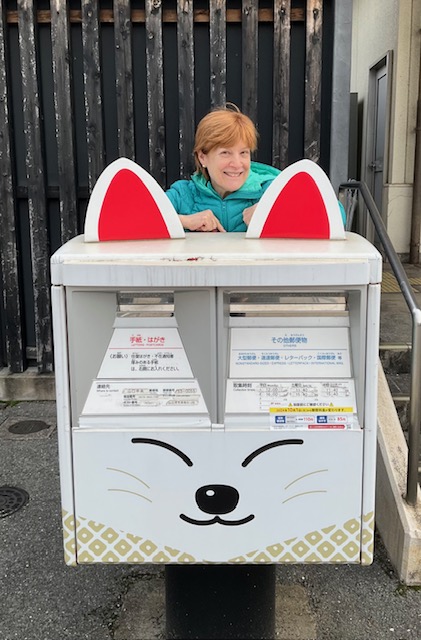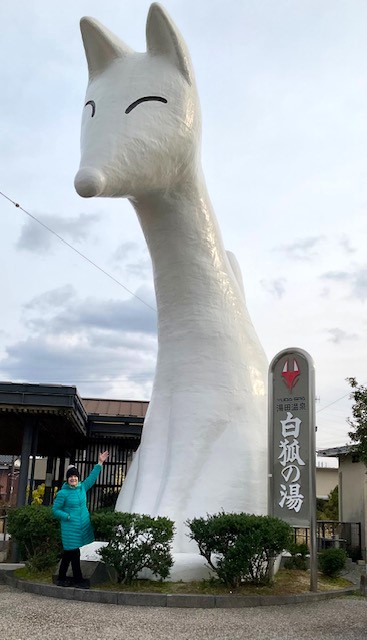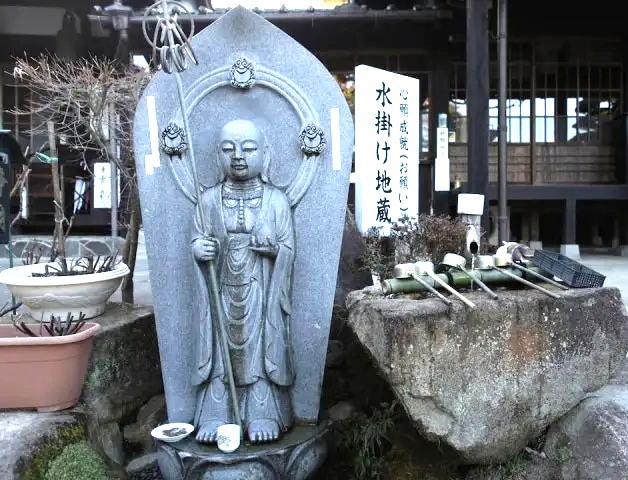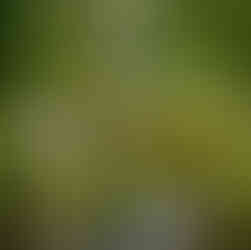How Yamaguchi Surprised Us (Part 1): Hidden Gems, Pagodas & Fugu
- By Zen Gaijin

- Jan 17
- 8 min read
Updated: Aug 11
Foxes. Fugu. A pagoda wrapped in scaffolding.
That’s not how we expected to kick off our Yamaguchi Japan travel guide—but then again, Yamaguchi rarely does what you expect.
We were there thanks to a bold claim by writer Craig Mod, who called Yamaguchi City “weirdly delightful” and helped land it the No. 3 spot on the New York Times’ “52 Places to Go in 2024” list—right after Paris.

Curious and skeptical, we rolled in. What we found was a patchwork of quiet charm, surprise discoveries, and a few misses, all tucked into the westernmost tip of Honshu.

Tourism to Yamaguchi City—and indeed the entire prefecture—has been increasing steadily, spurred in part by Mod’s praise. “Yamaguchi is often called ‘The Kyoto of the West,’ although it’s much more interesting than that—and it suffers from considerably less ‘tourism pollution.’ "

To get a complete handle on this comparison, it’s worth noting that historically, Yamaguchi City was modeled on Kyoto. In fact, 500 years ago, it was a larger and far more vibrant center than it is today, so it’s safe to say that Yamaguchi City is making a comeback.
Quick Take: Is Yamaguchi City Worth It?
We came to Yamaguchi City curious—thanks to Craig Mod’s glowing write-up. But if we’re being honest? Our take was a little more muted.

Unlike Mod, we didn’t spend days chatting up locals or peeling back cultural layers. Our visit was brisk—a drive-through tour with a few scenic detours and some lovely urban moments. One gingko-lined street, blazing gold and buzzing with life, gave us a glimpse of the charm Mod described. But on the whole, we found the city quieter and more subdued than expected.
That said, the rest of Yamaguchi Prefecture? It had us hooked. From fox-guarded hot springs to ancient temples and daring cuisine, what we found beyond the city limits made this trip unforgettable.
Yuda Onsen: Healing Waters & Watchful Foxes
If you’ve ever wanted to dip your toes into Japan’s hot spring culture—literally—Yuda Onsen is the place to start.
This low-key onsen town just outside Yamaguchi City may not dazzle at first glance, but it more than earns its place on the itinerary. Every day, over 2,000 tons of soft, alkaline water surge from its natural springs, known for easing aches, soothing muscles, and giving skin that elusive mochi glow. Locals swear by its powers. We became believers after one long soak.
But Yuda Onsen isn’t just about steamy baths. It’s also a town with a mascot—and not the kind you’d expect.
The fox is hard to miss—but don’t forget to look up.
Legend says that centuries ago, a wounded white fox stumbled upon these springs and was miraculously healed. The fox has watched over Yuda Onsen ever since, immortalized in statues, street signs, even post boxes. The biggest tribute? A 27-foot-tall fox statue towering above Yuda Onsen Station, equal parts guardian and selfie magnet.
Not up for a full soak? You don’t need to book a ryokan to enjoy the waters. Six public foot baths, or ashiyu, dot the streets—each one covered and open late, free of charge. We tried several. Each was different. Each worked its quiet magic.
Yuda Onsen’s public footbaths invite weary travelers to soak, rest, and smile.
Is Yuda Onsen jaw-droppingly beautiful? Not really. But that’s part of its charm. It feels lived-in, real, and refreshingly untouristy. Even better, it’s just minutes from the Shin-Yamaguchi Shinkansen station, making it the perfect launchpad for exploring the wider wonders of Yamaguchi Prefecture.
Top 3 Things to Do in Yamaguchi Prefecture (That Most Tourists Miss)
Yamaguchi Prefecture is a surprisingly great place to practice your Japanese driving skills. The region is filled with easy-going loops perfect for exploring by rental car—some take you to busy must-sees, others to quiet corners where you’ll feel like you have Japan to yourself.
Here are three stops we think are absolutely worth your time:
⛪ 1. A Cathedral in a Kimono Country: Xavier Memorial Church
Before heading out of town, make time for Xavier Memorial Church—a striking white structure with twin towers, more reminiscent of Europe than Japan. Built to commemorate St. Francis Xavier’s 1550 visit, it honors themes of light, water, and tents in vibrant stained glass. The church marks not just a religious moment, but a centuries-old spirit of welcome and global connection.



🏯 2. The Postcard Pagoda (Currently in Hiding): Ruriko-ji Temple
Even if you’ve pagoda-hopped across Japan, the five-story tower at Ruriko-ji—built in 1442—is in a league of its own. Often hailed as one of the most beautiful in the country, it’s a designated National Treasure and a symbol of Yamaguchi’s historic pride.

So yes, the postcard-perfect view is temporarily off-limits. But the serene gardens, quiet ponds, and Ruriko-ji Temple Museum are still open—and absolutely worth your time.

Don’t miss the Mizukake Jizō, a tranquil statue where hopeful visitors pour ladles of water while making silent wishes. This peaceful ritual adds quiet magic to the already meditative temple grounds.
Mizukake Jizō: A quiet guardian believed to grant wishes when sprinkled with water.
Visitors pour water over the statue and make a silent wish—an old custom still alive today.
Just beyond, a miniature stone pagoda and serene temple grounds invite lingering reflection.
Right next door, you’ll also find the Ouchi Clan Mausoleum, with kofun (ancient burial mounds) tucked into a shaded grove. It’s a peaceful, slightly eerie place that adds a historical depth to the visit.

Even with the pagoda under wraps, this peaceful site offers a rich walking route through temple halls, historic landmarks, and quiet gardens.

📍 Address: 7-1 Kozan-cho, Yamaguchi City
🕒 Temple Grounds: Open 24 hours / year-round
🕒 Museum: 9:00 AM–5:00 PM
🍁 3. Sesshū’s Garden Masterpiece: Joei-ji Temple & Sesshutei

We’ve seen a lot of temples and gardens across Japan—from Kyoto’s marquee icons to hidden Zen pockets in remote prefectures. But Joei-ji Temple and its Sesshutei Garden genuinely rank among the best we’ve ever visited.

The temple itself is quiet, understated—easy to miss if you’re not looking. But once you step through the gate, you're drawn into a slow, unfolding experience. First comes the Nanmei Garden, a pristine dry landscape that calms the mind. If this garden were in Kyoto, it would be swarmed with tourists—but here, it’s just you, the gravel, and the breeze.

And then: Sesshutei.
Leaving Nanmei, you pass through the temple’s interior, where rooms are adorned with magnificent painted panels and arrive in the splendor of Sesshutei.
Designed by legendary ink painter Sesshū Tōyō in the Muromachi period, this garden is less a display and more a living painting. Stone, water, trees, and moss are placed with a painter’s instinct for perspective and flow. There’s a stone waterfall, a curving path through carefully composed groves, and at its center, a pond shaped like the kanji for “heart.”
We visited in December, expecting the garden to feel dormant. Instead, we found trees ablaze in late-season yellows and reds. We stayed far longer than we planned—pulled in by the beauty, the hush, the sense of timelessness. It was, without exaggeration, one of the most peaceful and profoundly moving garden experiences we’ve ever had in Japan.
Scenes from Sesshutei: Water, stone, and foliage blend into a living painting that shifts with the seasons.
📍 Address: 2001-1 Miyanoshimo, Yamaguchi
🕒 Hours:
• April–November: 8:00 AM–5:00 PM
• December–February: 8:00 AM–4:30 PM
Together, these three places reminded us why we love getting off the beaten path in Japan. Yamaguchi City didn’t wow us with flash—but it surprised us with depth, history, and moments of stillness that linger long after you leave.
🎯 Deadly Delicious: Why Fugu Is the Ultimate Culinary Thrill in Yamaguchi
Of all the things we planned to eat in Yamaguchi, one dish stood out—partly because it could, in theory, kill you.
We're talking, of course, about fugu—the infamously toxic pufferfish that carries a poison said to be 1,200 times more lethal than cyanide. There’s no antidote. One wrong cut, and… well, you get the idea.

And yet, the Japanese have been eating fugu for over 10,000 years. Archaeologists have found fugu bones in Jomon-era ruins across Yamaguchi Prefecture, making it not just a delicacy, but a deeply rooted part of the region’s culinary heritage.
That heritage hasn’t always been celebrated. During the Edo period, the shogunate banned fugu after too many samurai met an unfortunate end. The ban was lifted in 1888, and ever since, it’s been a coveted gourmet experience—prepared only by chefs with years of training and a hard-earned license.
Yamaguchi is widely considered the fugu capital of Japan, and we couldn’t leave without trying it. We opted for sashimi—paper-thin slices fanned out like petals across a lacquered dish.
The flavor? Subtle. The texture? Clean, with just enough bite. But the real thrill came from knowing the story behind the fish—and trusting that our chef had mastered one of Japan’s most exacting culinary arts.
Would we eat it again? Absolutely. Just maybe not while rereading the part about cyanide.
Where to Stay: Your Secret Retreat in Yuda Onsen
If you’re planning to explore Yamaguchi Prefecture, base yourself in Yuda Onsen. Not only is it just minutes from the Shin-Yamaguchi shinkansen station, but it also offers a range of accommodations—from modest inns to refined ryokan—at price points that won’t make you flinch.

Our top pick? The serene and spectacular Kokian.
Tucked behind a tall wall on Yuda Onsen’s main street, Kokian looks almost like a local temple from the outside. Step through the gate, though, and you’re in another world.
Think: rich dark wood interiors, hushed hallways, and a central courtyard that feels more like a private villa than a hotel. Kokian describes itself as a hermitage—and it’s true. There’s a tranquility here that invites you to slow down, breathe deeply, and stay awhile.
Clockwise from top left: the serene lobby, an exquisite kaiseki dinner, a glowing open-air bath, and a private guest suite with its own onsen pool.
Kokian doesn’t advertise itself loudly—but that’s part of its magic. It’s the kind of place you want to keep to yourself… but can’t help telling everyone about.
While Kokian has an official website in Japanese (kokian.co.jp), many English-speaking travelers may find it easier to book through third-party platforms such as Japanican.com, Rakuten.com, Agoda.com, or Trip.com.
🛏️ Kokian Ryokan
Address: 4-4-3 Yudaonsen, Yamaguchi-shi, Yamaguchi PrefectureNote: Upscale ryokan with private onsen baths. Advanced reservations required.
© 2025 Zen Gaijin. This content is original research and may not be reproduced without permission.































